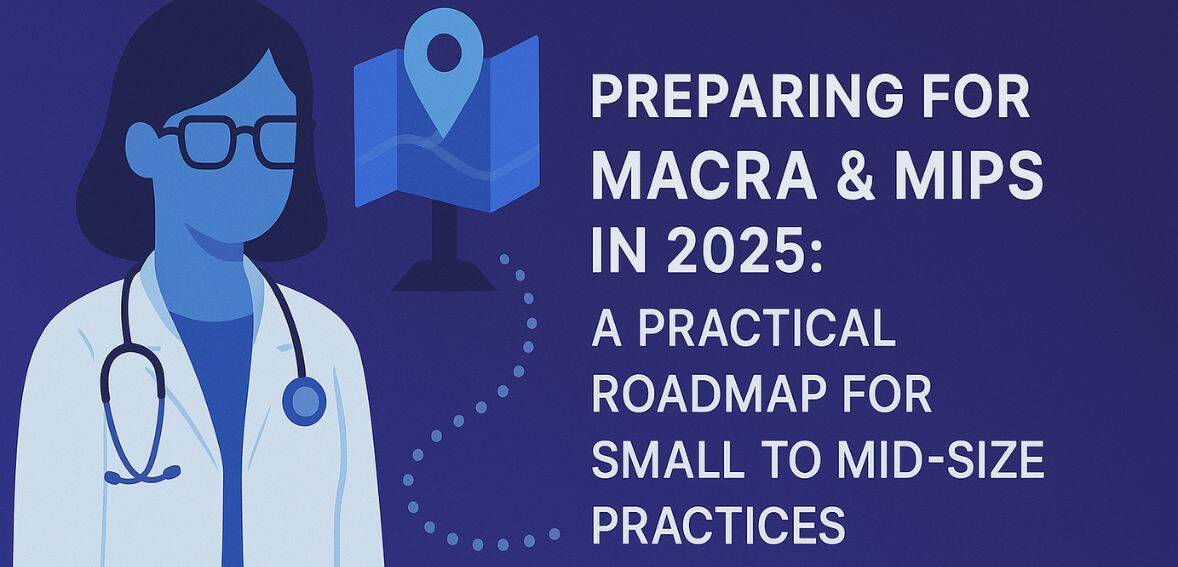
Preparing for MACRA & MIPS in 2025: A Practical Roadmap for Small to Mid-Size Practices
Particularly for small to mid-sized medical practices, the Medicare Access and CHIP Reauthorization Act (MACRA) remains a key element in the transformation of the American healthcare payment system. Through the Advanced Alternative Payment Models (APMs) or the Merit-based Incentive Payment System (MIPS), MACRA incentivizes physicians to deliver higher-quality care.
The operational and regulatory frameworks pertaining to MACRA & MIPS are changing as 2025 draws near in response to changes in government policy priorities, care delivery models, and technology advancements. Preparing for the upcoming changes for smaller practices involves more than just compliance; it also entails securing long-term clinical and financial viability.
The more popular track is still MIPS, particularly for practices that have not yet reached the APM participation threshold. The four main performance categories that determine MIPS scores are Quality, Cost, Improvement Activities, and Promoting Interoperability. Every category has been recalculated for 2025 to account for increased demands on patient outcomes, interoperability, and value-based care.
Practices hoping to optimize performance and payment adjustments must comprehend these changes at an early stage. Instead of rewarding more care, MACRA’s real aim? It is not just more care—it is better care. That’s why in 2025, expect a sharper focus on outcomes, tighter coordination, and smarter resource use.
Anticipating the Regulatory Shifts and Policy Emphasis

The deeper integration of equity-based performance measures and population health metrics is one of the most significant modifications to the MACRA and MIPS framework for 2025. In order to mandate that practices record and address health disparities, CMS has added new data collection points and scoring considerations.
This change is a reflection of national policy initiatives to promote health equity, which require physicians to use metrics beyond traditional performance evaluations. Providers will have to use tools that enable detailed reporting on population segments and interact with Social Determinants of Health (SDOH) data.
These modifications to the policy emphasize the necessity of flexibility. In order to ensure that every clinical interaction supports their MIPS performance, small and mid-size practices need to be flexible enough to implement the required tools and rethink internal workflows. This entails switching from a volume-based scheduling system to one that supports outcome tracking, follow-up coordination, and thorough care planning. Practices that view MIPS as a framework for ongoing improvement rather than as a regulatory barrier will be the ones that thrive in 2025.
Implementing Performance Optimization Through Workflow Alignment

The first step in successfully preparing for MIPS in 2025 is to match daily operations with performance goals. For example, by mapping patient pathways to current reporting benchmarks, practices can better align with quality measures. which make up the majority of the MIPS score. A practice should make sure that all clinical touch points are coded and documented in a way that supports pertinent quality benchmarks, for example, if it regularly treats chronic conditions like diabetes or hypertension.
Practices must handle referrals, diagnostics, and prescription drug prescriptions more carefully in order to meet cost efficiency, another important MIPS score pillar. This includes clinical education in addition to financial oversight, allowing care teams to balance treatment cost and effectiveness. Practically speaking, this could entail developing dashboards that highlight patients who use the emergency room a lot or spotting polypharmacy trends that could be simplified.
Enhancement In 2025, Think of team-based care as the engine driving your MIPS success—every part needs to fire in sync. Multidisciplinary cooperation between doctors, nurses, case managers, and administrative personnel should be promoted by practices.
In addition to improving care, internal training initiatives on telehealth management, patient outreach strategies, and care protocols will raise MIPS scores. Workflow alignment also helps to promote interoperability. It is crucial to make sure that employees understand data privacy regulations, are skilled in creating reports, and are proficient in using EHRs.
Integrating Telehealth into MIPS Planning
MACRA/MIPS in 2025 formally acknowledges the value of telehealth, which has evolved from an emergency tool during the pandemic to a mainstream method of delivering care. Two essential components of care coordination and cost-effectiveness are efficiency and accessibility, which can be enhanced by incorporating telehealth into regular workflows.
For many small practices, this might offer a scalable path grow their services without having to make large investments in physical infrastructure. But the key to success is thorough documentation and proper coding, which are essential for data accuracy in the Quality Payment Program (QPP).
To ensure compliance, virtual visits must be anchored by platforms that meet CMS guidelines. Additionally, telehealth can be used to provide behavioral health and chronic care management services while still being eligible for MIPS incentives. As digital care delivery continues to gain traction, early adopters are likely to benefit from better patient reach, improved metrics, and increased bonus eligibility.
Enhancing Patient Engagement to Improve MIPS Scores

Under MIPS, patient engagement has a direct impact on performance scores and is no longer a secondary aspect of care. Small and mid-sized practices must prioritize proactive communication and individualized care journeys in 2025 due to the emphasis on patient-centered outcomes.
Medication adherence, follow-up compliance, and patient education are reinforced by tools such as patient portals, mobile health apps, payment plans, and SMS reminders. Practices typically see improvements in outcomes like blood pressure control, diabetes management, and fewer readmissions when patients are actively involved in their care. These outcomes are measured using MIPS quality measures.
Additionally, using digital surveys to gather real-time patient feedback helps the “Improvement Activities” category. Making sure your staff is educated in tech-assisted engagement techniques and empathic communication can significantly increase MIPS scoring potential while increasing patient satisfaction and retention.
Data Accuracy and Real-Time Monitoring as Key Levers
Since performance-based reimbursement has become usual, precise, real-time data monitoring has become crucial. It is now imperative for small and mid-sized practices to invest in data infrastructure that satisfies this requirement. HER systems need to be able to identify incomplete visits, missing paperwork, and follow-up care errors.
Clinical and administrative personnel can react proactively to performance gaps by using dashboards that display MIPS categories in real time. Another important factor in audit defense is data accuracy. In 2025, CMS audits are anticipated to increase, and practices are required to keep track of performance documentation, particularly for attestations of quality and improvement activities. A systematic approach to gathering, storing, and retrieving data will be used as a strategic performance tool as well as a compliance measure.
Routine tasks like follow-up tracking, patient reminders, and coding checks can be automated to free up practices to concentrate on clinical quality and patient engagement. Patient-reported outcomes (PROs) are another aspect of data readiness. CMS is placing a greater emphasis on PROs in both cost and quality metrics.
Practices should think about using surveys or online resources to get input on patient satisfaction, treatment effectiveness, and involvement. Clinicians can stay informed about patient expectations and satisfaction trends by incorporating these inputs into performance review meetings.
Financial Planning and Resource Allocation

Future-focused financial planning is necessary to get ready for MIPS in 2025. Practices must predict their risk and reward scenarios because performance-based adjustments may cause significant fluctuations in revenue. Modeling various MIPS performance levels and evaluating their effects on cash flow should be part of practice.
This enables them to focus resources on high-impact initiatives like staff training, HER upgrades, or outside consulting assistance. Pooled resources can be a smart move for smaller practices with narrower profit margins. Joining Accountable Care Organizations (ACOs) or Independent Practice Associations (IPAs) may provide access to compliance resources, a common reporting infrastructure, and group bargaining power.
In addition to lessening the personal burden of compliance, these cooperative models also give practices a favorable place in value-based care networks. Also state-based incentive programs and grants continue to be underutilized sources of funding for care coordination pilots or technology upgrades. In order to support their investment in MIPS preparation, practices should look into federal and state funding options. To prevent cash flow problems or last-minute compliance expenses, financial planning must also be in line with regulatory timelines and reporting periods.
Cultivating a Culture of Continuous Improvement
In addition to technical compliance, fostering a continuous improvement culture will be essential for navigating MACRA and MIPS successfully in 2025. Physicians and practice managers must make a commitment to continuous learning, process evaluation, and patient-centered innovation at the highest level of leadership. Every team member, from front desk employees to clinicians, must comprehend their role in influencing performance outcomes in smaller settings in order to implement cultural transformation.
Internal evaluation can benefit from frequent patient experience audits, interdisciplinary feedback sessions, and quarterly performance reviews. The intention is to instill a mindset that values performance transparency, actionable data, and feedback. This cultural change guarantees that the practice will continue to be flexible even as policy changes after 2025 and builds resilience against regulatory uncertainty.
This culture can be supported by technology, which makes data accessible and useful. Accountability is strengthened by tools that send staff members daily or weekly performance summaries. In a similar vein, gamification techniques that recognize and reward high-achieving groups or individuals can raise spirits and help teams align their efforts with MIPS objectives. In the end, creating a culture of continuous improvement begins with strong practice recruitment and aligning every team member with performance goals.
Strengthening Vendor Partnerships for MIPS Compliance
Choosing the right technology and service vendors can make or break your MIPS success. From HER providers to analytics firms and compliance consultants, third-party partners play a crucial role in performance tracking, gap analysis, and timely reporting. Small to mid-size practices often lack in-house resources to manage data warehousing or regulatory updates, making vendor support indispensable.
In 2025, it is essential to vet vendors not only for HIPAA compliance but also for their proven capabilities in MACRA-related functions like eCQMs (electronic clinical quality measures), real-time performance dashboards, and CMS submission readiness. Practices should maintain open communication with vendors to stay ahead of deadlines and ensure smooth data interoperability.
Ideally, these partnerships should include regular system audits, training support, and updates aligned with evolving federal guidelines. Effective collaboration results in fewer reporting errors, better performance feedback, and higher composite scores.
Conclusion: The Road Ahead for Small to Mid-Size Practices
The complexity of MACRA and MIPS participation in 2025 presents opportunities as well as challenges for small and mid-sized practices. Regulatory literacy, workflow alignment, technology investment, financial foresight, and cultural preparedness will all be necessary for success.
The potential for better patient outcomes, increased practice efficiency, and favorable payment adjustments makes the effort worthwhile, even though the burden of compliance may seem heavy. Ticking regulatory boxes is only one aspect of MACRA and MIPS preparation.
It involves rethinking the way that care is provided, evaluated, and incentivized. In a value-driven healthcare economy, practices that start this transition now—by making investments in data infrastructure, encouraging interprofessional collaboration, and ingraining a mindset of continuous improvement—will not only withstand the changes that lie ahead, but also come out stronger, more competitive, and more patient-centered.